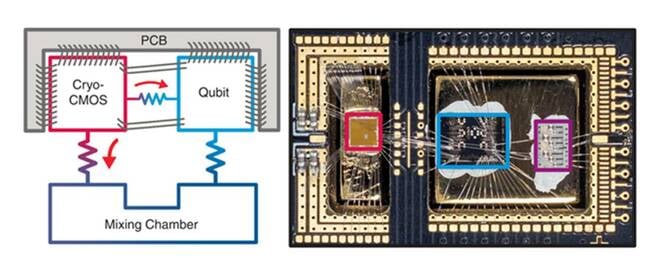This article is more than 1 year old
Microsoft's Gooseberry is a dish best served really, really cold: Progress made on silicon quantum computing
None of that nuclear-magnetic-resonance garbage, ha
Microsoft says it has made progress in its effort to develop CMOS-based chips for quantum computing.
Complementary metal–oxide–semiconductor (CMOS) technology – an integrated circuit manufacturing process – is used to make a variety of computer components. And many of the scientists developing quantum computers would prefer to use this familiar approach to build machines that realize quantum bits, or qubits, instead of relying on more exotic mechanisms that have been explored like liquid-state nuclear-magnetic-resonance or ion traps.
Qubits are to quantum computers what binary bits are to classical computers, the state measured for computation. Qubits represent the state of a quantum system, which can be determined by measuring subatomic particles like the spin of electrons or the polarization of photons.
The idea of a silicon-based quantum computer dates back to a 1998 paper from Bruce Kane, then a researcher at Australia’s University of New South Wales. But developing a practical implementation has proven to be a challenge because, among other things, CMOS components tend to throw off heat and that interferes with qubits. The first programmable quantum processor using silicon was described by researchers in the Netherlands in 2018.
Useful quantum computers will be impossible without error correction. Good thing these folks are working on it
READ MOREQubits in such machines depend on storage at near-zero Kelvin temperatures, a feat that has required extensive refrigeration hardware and wiring for each qubit. That becomes a problem when you need millions of them, more or less the number of qubits estimated to be necessary for the sort of general-purpose quantum computer that research scientists hope to build.
In a paper published this week in Nature Electronics, researchers from Microsoft and the University of Sydney, Australia, explain how they've developed a chip called Gooseberry that can support thousands of qubits – significantly more than the 65-qubit design touted by IBM last year – though they haven't actually made such a device.
"The chip powering this platform, called Gooseberry, resolves several issues with I/O in quantum computers by operating at 100 milliKelvin (mK) while dissipating sufficiently low power so that it does not exceed the cooling power of a standard commercially-available research refrigerator at these temperatures," explained Chetan Nayak, general manager of quantum hardware at Microsoft in a blog post. "This sidesteps the otherwise insurmountable challenge of running thousands of wires into a fridge."
The researchers, led by University of Sydney professor David Reilly, have also devised a cryo-compute core that sits above Gooseberry in the quantum stack to relay information from the quantum layer. The core, a general-purpose CPU, is designed to operate at a higher though still rather chilly temperature – 2 K as compared to 100 mK. According to Nayak it deals with some triggering functions, data handling, and branching decision logic and thus requires more circuit blocks and transistors.
"The core acts as an intermediary between Gooseberry and executable code that can be written by developers, allowing for software-configurable communication between the qubits and the outside world," explains Nayak.
In the same way, this research represents an intermediary step toward a functional, general purpose quantum device. Nayak concedes other breakthroughs have to happen – like error correction – but he insists Microsoft is in it for the long haul. ®

